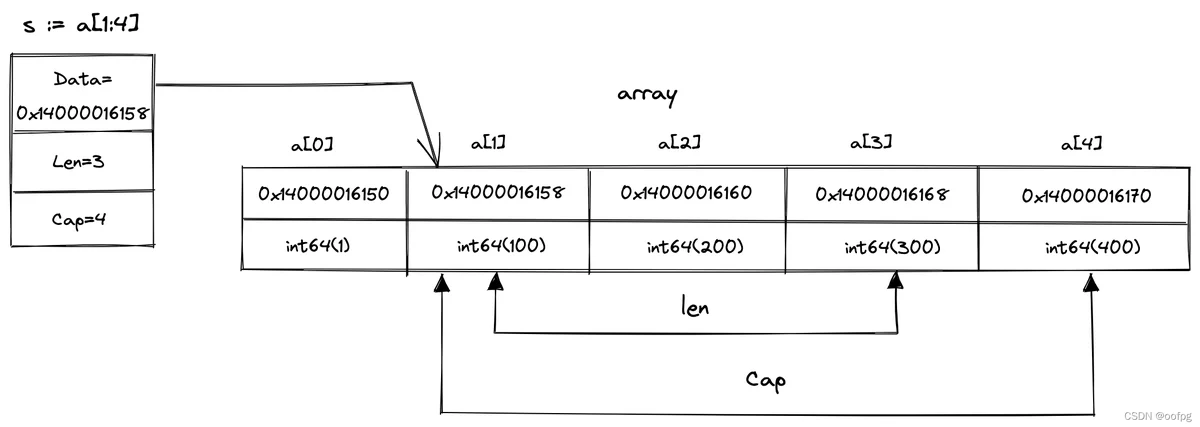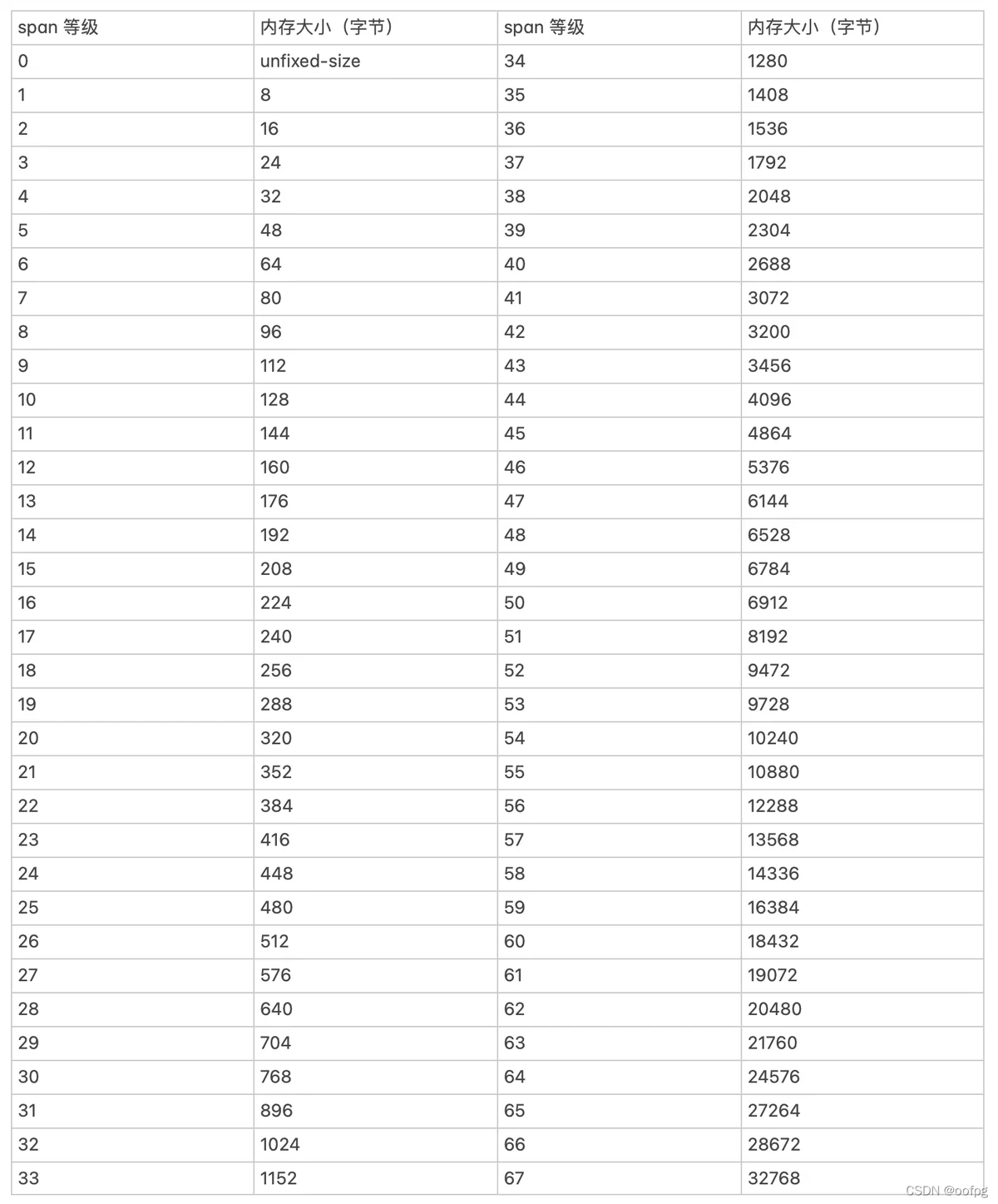环境
摘要go1.17.8 darwin/arm64
- slice特点
- slice初始化
- slice遍历
- slice数据结构
- slice追加和扩容
- slice拷贝
slice(切片)
1.slice特点
- 切变的长度是可变的
- 切片是对底层数组的引用
- 切片存储的元素类型是相同的
- 可以存储相同的元素(相比于set)
2.slice初始化
- 使用字面量
- 会初始化一个匿名的底层数组,然后将s指向该数组的第一个元素
s := []int{1,2,3}
- 基于已经存在的数组
- high表示上界:默认值为数组的长度
- low表示下界:默认值为0
- low和high限定切片能访问数组下标的范围,但不包括第high个元素:即左闭右开
// array[low:high]
a := [5]int{1,2,3,4,5}
// 以下两种表示方式是相同的
s := a[:] //s := a[0:len(a)]
- 基于已经存在的切片
- 与基于数组相似,但low和high限定新切片能访问老切片的下标范围
// slice[low:high]
s := []int{1,2,3,4,5}
s2 := s[1:]
- 使用make关键字
- 第一个参数:元素的类型
- 第二个参数:切片长度
- 第三个参数:切片的容量(可省略)
// slice := make([]T, len, cap)
s := make([]int, 4, 7)
s2 := make([]int, 7)
3. slice遍历
两种遍历方式
- 使用下标
s := []int{1,2,3}
for i:= 0 ; i < len(s); i++ {
fmt.Println(s[i])
}
- 使用range
s := []int{1,2,3}
for i,v := range s {
fmt.Println(i,v)
}
// 或者:可以身略i,i表示访问到第几个元素(从0开始)
for _,v := range s {
fmt.Println(i,v)
}
4. slice数据结构
运行时数据结构如下:
// SliceHeader is the runtime representation of a slice.
// It cannot be used safely or portably and its representation may
// change in a later release.
// Moreover, the Data field is not sufficient to guarantee the data
// it references will not be garbage collected, so programs must keep
// a separate, correctly typed pointer to the underlying data.
type SliceHeader struct {
Data uintptr
Len int
Cap int
}
- Data:指向切片可访问底层数组的第一个元素,可能不是底层数组的第一个元素(详见下图)
- Len:切片长度,表示切片可以被访问的元素个数
- Cap:切片容量,表示切片可以容纳最大的元素个数

5. 追加和扩容
语法
s1 := []int{1,2,3}
s2 := append(s1, []int{1,2,3,4}...)
思考
在64位机器上,s2的len和cap分别是多少?
预估扩容后切片容量大小
扩容规则:
- 如果期望容量大于当前容量的两倍,则新分配的容量等于期望容量。
- 如果期望容量小于当前容量的两倍:
- 如果当前容量小于1024,则新分配的容量等于当前容量的两倍
- 如果大于1024则每次增加1.25倍,直到大于期望容量为止。
func growslice(et *_type, old slice, cap int) slice {
...
newcap := old.cap
doublecap := newcap + newcap
if cap > doublecap {
newcap = cap
} else {
if old.cap < 1024 {
newcap = doublecap
} else {
// Check 0 < newcap to detect overflow
// and prevent an infinite loop.
for 0 < newcap && newcap < cap {
newcap += newcap / 4
}
// Set newcap to the requested cap when
// the newcap calculation overflowed.
if newcap <= 0 {
newcap = cap
}
}
}
...
}
总的来说,主要的目的是:在容量小于1024时防止小块内存的频繁分配和拷贝,通过每次增长至少两倍的方式,能够减少可能重新分配的次数;当容量大于1024时,这时如果只是单纯的还是以至少两倍的空间扩容,很可能会浪费额外的空间(也许某次扩容期望的容量只是稍大于当前容量)
匹配合适的内存块大小
所需内存 = 预估容量 * 元素类型大小
在slice扩容时,需要计算合适的内存大小用于分配,预估容量并不一定就是最终新slice的cap。Go的内存管理模块将内存的大小分为不同规格的span,总计68种。内存管理模块会找到最合适的span规格用于slice扩容时的内存分配。

解答:
s1 := []int{1,2,3}
s2 := append(s1, []int{1,2,3,4}...)
在64位机器中,int占8个字节,所以append之后len=7,预估有7 * 8 = 56字节的大小需要分配,对应上图最接近的符合条件的span等级是6,即64字节,所以新的slice的cap = 64 / 8
源码解析:
func growslice(et *_type, old slice, cap int) slice {
...
var overflow bool
var lenmem, newlenmem, capmem uintptr
// Specialize for common values of et.size.
// For 1 we don't need any division/multiplication.
// For sys.PtrSize, compiler will optimize division/multiplication into a shift by a constant.
// For powers of 2, use a variable shift.
switch {
case et.size == 1:
lenmem = uintptr(old.len)
newlenmem = uintptr(cap)
capmem = roundupsize(uintptr(newcap))
overflow = uintptr(newcap) > maxAlloc
newcap = int(capmem)
case et.size == sys.PtrSize:
lenmem = uintptr(old.len) * sys.PtrSize
newlenmem = uintptr(cap) * sys.PtrSize
capmem = roundupsize(uintptr(newcap) * sys.PtrSize)
overflow = uintptr(newcap) > maxAlloc/sys.PtrSize
newcap = int(capmem / sys.PtrSize)
case isPowerOfTwo(et.size):
var shift uintptr
if sys.PtrSize == 8 {
// Mask shift for better code generation.
shift = uintptr(sys.Ctz64(uint64(et.size))) & 63
} else {
shift = uintptr(sys.Ctz32(uint32(et.size))) & 31
}
lenmem = uintptr(old.len) << shift
newlenmem = uintptr(cap) << shift
capmem = roundupsize(uintptr(newcap) << shift)
overflow = uintptr(newcap) > (maxAlloc >> shift)
newcap = int(capmem >> shift)
default:
lenmem = uintptr(old.len) * et.size
newlenmem = uintptr(cap) * et.size
capmem, overflow = math.MulUintptr(et.size, uintptr(newcap))
capmem = roundupsize(capmem)
newcap = int(capmem / et.size)
}
// The check of overflow in addition to capmem > maxAlloc is needed
// to prevent an overflow which can be used to trigger a segfault
// on 32bit architectures with this example program:
//
// type T [1<<27 + 1]int64
//
// var d T
// var s []T
//
// func main() {
// s = append(s, d, d, d, d)
// print(len(s), "\n")
// }
if overflow || capmem > maxAlloc {
panic(errorString("growslice: cap out of range"))
}
var p unsafe.Pointer
if et.ptrdata == 0 {
p = mallocgc(capmem, nil, false)
// The append() that calls growslice is going to overwrite from old.len to cap (which will be the new length).
// Only clear the part that will not be overwritten.
memclrNoHeapPointers(add(p, newlenmem), capmem-newlenmem)
} else {
// Note: can't use rawmem (which avoids zeroing of memory), because then GC can scan uninitialized memory.
p = mallocgc(capmem, et, true)
if lenmem > 0 && writeBarrier.enabled {
// Only shade the pointers in old.array since we know the destination slice p
// only contains nil pointers because it has been cleared during alloc.
bulkBarrierPreWriteSrcOnly(uintptr(p), uintptr(old.array), lenmem-et.size+et.ptrdata)
}
}
memmove(p, old.array, lenmem)
return slice{p, old.len, newcap}
}
- 上面的switch,case代码段中主要是计算:
- lenmem:原先切片内的元素所占内存大小
- newlenmem:原先切片内的元素加新增的元素后所占内存大小
- capmem:扩容后切片所占最大内存大小
- 下面if,else中代码,主要分两种情况:
- slice中元素是值类型
- mallocgc:
- memclrNoHeapPointers:由于GC释放的内存单元中可能原先存在脏值,但其实只需要将多余分配的部分清空即可。在之前的例子中即s[7:8]的区域。
- slice中元素是指针类型
- slice中元素是值类型
测试用例
func Test_SliceAppend(t *testing.T) {
s := make([]int, 3, 3)
s1 := append(s, []int{1,2,3,4}...)
// the result is
//s1:len=7, cap=8
//new_cap = cap(64 / 8)
// 7 * 8 byte = 56B
//span level 6 = 64B
t.Logf("s1:len=%d, cap=%d \n", len(s1), cap(s1))
t.Logf("s:ptr=%p, s1:ptr=%p \n", s, s1)
s = make([]int, 256, 256)
s1 = append(s, 1)
// the result is
//s1:len=257, cap=512
//new_cap = double old_cap
t.Logf("s1:len=%d, cap=%d \n", len(s1), cap(s1))
s = make([]int, 1024, 1024)
s1 = append(s, 1)
// the result is
//s1:len=1025, cap=1280
//new_cap = old_cap * 1.25
t.Logf("s1:len=%d, cap=%d \n", len(s1), cap(s1))
}
6. slice拷贝
// slicecopy is used to copy from a string or slice of pointerless elements into a slice.
func slicecopy(toPtr unsafe.Pointer, toLen int, fromPtr unsafe.Pointer, fromLen int, width uintptr) int {
if fromLen == 0 || toLen == 0 {
return 0
}
...
if size == 1 { // common case worth about 2x to do here
// TODO: is this still worth it with new memmove impl?
*(*byte)(toPtr) = *(*byte)(fromPtr) // known to be a byte pointer
} else {
memmove(toPtr, fromPtr, size)
}
return n
}
- 若src_slice 或dst_slice任意长度位0,则无需复制直接返回 0
- 若 Slice 只有一个元素,则直接利用指针取值复制
- 若 Slice 大于一个元素,则调用memmove内存块直接拷贝
测试用例
func Benchmark_SliceCopy(b *testing.B) {
benchmarks := []struct {
name string
dst []int
src []int
}{
{
name: "zero",
dst: make([]int, 0),
src: make([]int, 0),
},{
name: "one",
dst: make([]int, 1),
src: make([]int, 1),
},{
name: "two",
dst: make([]int, 2),
src: make([]int, 2),
},{
name: "more",
dst: make([]int, 100),
src: make([]int, 100),
},
}
for _, bm := range benchmarks {
b.Run(bm.name, func(b *testing.B) {
for i := 0; i < b.N; i++ {
copy(bm.dst, bm.src)
}
})
}
/*
Benchmark_SliceCopy
Benchmark_SliceCopy/zero
Benchmark_SliceCopy/zero-10 1000000000 0.5941 ns/op
Benchmark_SliceCopy/one
Benchmark_SliceCopy/one-10 645597904 1.851 ns/op
Benchmark_SliceCopy/two
Benchmark_SliceCopy/two-10 622364944 1.915 ns/op
Benchmark_SliceCopy/more
Benchmark_SliceCopy/more-10 96457857 11.84 ns/op
PASS
*/
}
